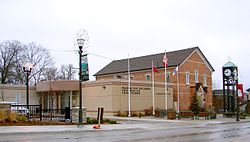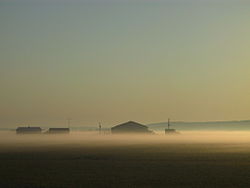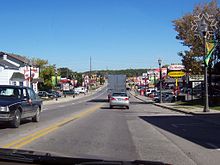
Bradford West Gwillimbury town hall
Bradford is the primary country urban area of the Town of
Bradford West Gwillimbury, Ontario, in Canada. It overlooks a
beautiful and prosperous farming community, known as The Holland
Marsh, located on the Holland River that flows into Lake Simcoe.
Within the municipal boundaries are a number of smaller communities,
including: Bond Head, Dunkerron, Green Valley, Pinkerton, Fisher's
Corners, Newton Robinson, Coulson and Deerhurst.
[edit]
History
The eastern boundary of Bradford is the Holland River, named for
Samuel Holland first Surveyor General of British North America, who
passed this way on an exploration from Toronto to Balsam Lake, by way
of Lake Simcoe, in 1791
For several years the Holland River and Lake Simcoe provided the
only means of transportation. Holland Landing was the northern
terminus of Yonge Street. The military route to Georgian Bay during
the war of 1812, crossed Lake Simcoe to Kempenfelt Bay, then by the
Nine Mile Portage to Willow Creek and the Nottawasaga River. The
Penetanguishene Road built between 1814–1815, from Kempenfelt Bay,
provided an alternate route to Georgian Bay, however, early settlers
also used this route to get to the frontier of Simcoe County,
bypassing the areas of West Gwillimbury and Essa townships.
The first settlers to cross the Holland River arriving in the fall
of 1819, were three Irishmen-James Wallace, Lewis Algeo and Robert
Armstrong. This was about the same time as the Auld Kirk Scotch
Settlement was established, however, the pioneers of West Gwillimbury
were mostly Protestants from Northern Ireland.
The new settlers sent a petition to the province of Upper Canada
early in 1824, stating they were separated from the settlements of
Yonge Street, by an impassable swamp. On January 24 the Legislative
Assembly of Upper Canada made a grant for the first main road in West
Gwillimbury (4 Geo. 1V., chap 29). The contract for the first Corduroy
road across the Holland Marsh, was completed by Robert Armstrong and
his sons in the fall of 1825. Connecting with other contactors
sections and the previously constructed road from Kempenfelt Bay, the
road became known as Penetanguishene Road. Later Yonge Street, now,
Simcoe County Road 4.
The original road (Bridge Street) did not curve onto Holland
Street, but continued straight to what is now Scanlon Ave. near
Colborne Street, from there the road continued north while another
road led southwest to the Scottish settlement. It was at this junction
that the settlement was first established. William Milloy, formerly of
Coulson’s Corners, built a small log tavern there in the fall of 1829.
Other businessmen included James Drury, merchant; James Campbell,
shoemaker and Thomas Driffel, blacksmith. John Peacock, an old soldier
from London, England, had settled as a merchant and became the first
postmaster in 1835.
[edit]
Bradford
becomes a town
Bradford was incorporated as a Village in 1857, with a population
of about 1,000 people. Only a few years prior to this, the Northern
Railway of Canada was built through the town. The train station was
constructed by the Grand Trunk Railway and later used by the CNR.
Bradford was incorporated as a town in 1960.
The Downtown Core has survived two fires. The first, on May 23,
1871, destroyed upwards of one hundred homes including all of the
business part of the village except two hotels being consumed.
However, a new downtown area arose where most buildings were made of
brick. Today many of the buildings still exist and make up the
downtown core. The second fire was in the 1960s with damage only to
the northwest corner of the intersection at Highway 11 and Highway 88.
One of its famous historical landmarks that still operates to this
day is the Village Inn Hotel.
[edit]
Early industry
The village of Bradford was established to supply the agricultural
interests of its surrounding area, for a brief period in the mid-19th
century, lumbering was a major industry, as trees had to be removed in
order to commence farming.
In 1824 entrepreneurs John Thorpe and Mark Scanlon obtained a
government grant for the construction of a grist mill on a stream
north of the settlement, although the partnership was dissolved about
1832, Scanlon built two sawmills in that vicinity. Water power being
the only means of motive power at the time, as many as six mills were
located on Scanlon Creek at one time. The family of Thomas Maconchy,
one of the early settlers of Gilford, built a sawmill in Bradford at
the bridge over the Holland River, in 1840. It was the first mill at
that location.
When the Ontario, Simcoe and Huron Railway was constructed, it was
said to be through an almost continuous forest for most of the
distance from Toronto to Barrie. Sometime after the line opened,
Toronto lumber merchant Thompson Smith put up a large sawmill on the
river near the Bradford station. First evidence of Smith in the
village was 1862 when his partner James Durham cut the Holland River
bridge in two, while driving logs to the mill.
Thompson Smith's mill was the second largest in the area, next to
the Sage mill at Bell Ewart. Smith added a second mill at Bradford, as
well as contracting with Durham's mill in Barrie. Only a decade after
the arrival of the railway at Lake Simcoe, pine for the mills was
running low. In 1867 H. W. Sage persuaded Thompson Smith to join with
him in the formation of the Rama Timber Transport Company, to supply
Lake Simcoe mills with timber. With logs coming from as distant as
Head Lake, Smith put up a third mill, south of the Holland River
bridge in 1869.
Following an example set by American lumberman Henry W. Sage,
Thompson Smith established a number of mills at Cheboygan, Michigan.

Bradford farmland - Primarily carrot crops
In 1923, William Henry Day began the drainage system that turned
the wetlands of the Holland Marsh into arable land, which now consists
of thousands of acres where fresh vegetables are grown.
[edit]
Demographics
The 2006 Statistics Canada Census lists the population of Bradford
West Gwillimbury (the local census unit) as 24,039.[1]
Bradford West Gwillimbury has people from many different backgrounds
ranging from Portugal, Italy, the Netherlands, Germany, United
Kingdom, Hungary, and Ukraine. The overwhelming majority of Bradford's
residents are White.
[edit]
Education
There are 12 schools in the town, including two secondary schools:
- Bradford District High School (Public)
- Holy Trinity High School (Catholic).
Elementary schools include:
Fred C. Cook Public School
Bradford Public School
WH Day Elementary School
Fieldcrest Elementary School
Sir William Osler Public School
Hon. Earl Rowe Public School
St. Charles Catholic School
St. Jean de Brebeuf Catholic School
Marie of the Incarnation Catholic School
Mother Teresa Catholic School
There are no university or college campuses in Bradford.

Holland St. East (Cty. Rd. 88) in Bradford on a Saturday
afternoon.
Bradford's downtown core is situated at the intersection of former
Highway 11 (now, County Road 4) and 88 (now, County Road 88). County
Road 88 intersects with Ontario's Highway 400, a limited-interchange
multi-lane major thoroughfare that connects to Toronto in the south
and "cottage country" in the north. This portion of Highway 11 is one
of the few connecting routes between Highway 404 to the east and the
400 to the west, creating considerable through traffic. It can be
tough to drive through the town on long weekends.
Public transit in Bradford is very limited. GO Transit has bus
routes that connect the town to Barrie and Newmarket, and Bradford
also has a station on GO Transit's commuter train network. The GO
Train service had its first inaugural run through Bradford in 1982. At
the time, the commuter train went as far north as Barrie. Over the
years the service to Barrie was stopped. This caused Bradford to be a
terminus for the commuter trains to Toronto. However, the City of
Barrie purchased the rail line north of Bradford with the hope of
reintroducing rail service to Barrie. GO Train service resumed as of
December 2007 to the city of Barrie.